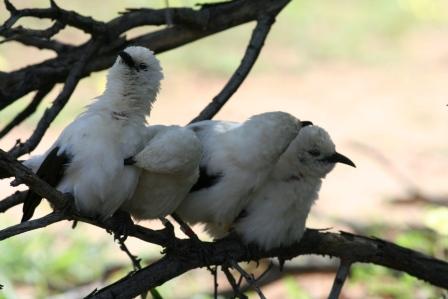Helping behaviour
All adult group members continue to provision actively begging young for between 2-4 months post-fledging. We conduct many investigations during this period, such as who helps the most and why, how this affects chick development, what the cost is to helpers, the dynamics of parent-offspring conflict, and offspring begging strategies
|
Group bondingBabbler groups are very cohesive, and interact constantly through vocal communication and physical contact. Group allopreening, where individuals huddle together and allopreen each other, is relatively common, as is playfighting. Although the youngsters are the most prodigious playfighters, adults are regularly seen to indulge in this activity as well.
|
A new host-parasite relationship
The recent arrival of cuckoos in the study population has generated much interest about the dynamic between the babbler hosts and cuckoo young. While some pied babblers will happily feed the cuckoo as if it is their own, others show strong rejection behaviour. We aim to investigate this host-parasite dynamic closely over the next few years
|
PlayfightingAlthough a behaviour considered unusual in birds, babbler spend a lot of time play fighting. Play fighting takes several forms. Seen most commonly in youngsters, all group members participate in play fighting behaviour.
|
The eyes have it....Sexing monomorphic birds can be terribly frustrating, especially when trying to collect data on immigrant individuals and juveniles. Luckily, the Arabian babblers make it easy for us. The female has an all black eye, whereas the male does not. Unfortunately the same is not true for pied babblers, so we rely on sexing using molecular techniques to confirm our behavioural observations.
|
Water, a precious resourceWater is a severely limiting resource in the desert regions inhabited by pied and Arabian babblers. Unfortunately, this has resulted in a number of deaths because they become attracted to man-made sources of water (farm troughs, holding dams etc). To avoid this, we occasionally give them a small drink to encourage them to stay away from man-made dwellings. We also give them a small water reward for getting on the scale to be weighed in high summer, when they find water more appealing than a food reward.
|
Eavesdropping on the neighbours?
Scimitarbills (Rhinopomastus cyanomelas) are a small 'near-passerine' bird with a curved bill uniquely adapted for probing for prey beneath the bark of acacia trees. However, their regular association with pied babblers and their heavy reliance on pied babbler alarm calls has led us to realize that scimitarbills may actually be using the pied babbler sentinel system to their advantage. Our research is currently looking at how scimitarbill foraging and vigilance behaviour changes when they associate with pied babbler groups.
|
Crafty KleptoparasitesFork-tailed drongos are crafty birds - they steal food from other bird species (including pied babblers) by giving false alarm calls and grabbing food from their startled hosts. This surely must be one of the cleverest birds in the Kalahari! My research on fork-tailed drongos has wound down and drongo research now is principally being driven by Dr Tom Flower. Tom continues to do fascinating research on this species, and we look forward to seeing more research on drongos, and their interaction with pied babblers, in the future.
|
RingingIn order to be able to follow individuals throughout their lives, each bird has to be individually recognisable. We give each bird three coloured and one metal ring as a nestling. Some rings fall off throughout the individual's life, but most stay on.
|


















